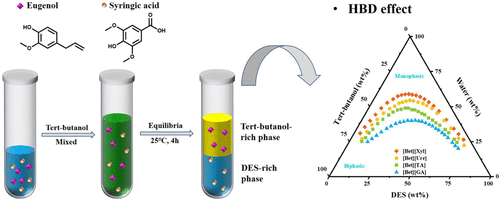当前位置:
X-MOL 学术
›
J. Chem. Eng. Data
›
论文详情
Our official English website, www.x-mol.net, welcomes your
feedback! (Note: you will need to create a separate account there.)
Pseudoternary Systems of Deep Eutectic Solvents + tert-Butanol + Water at T = 288.15 K, 298.15 K, and 308.15 K: Liquid–Liquid Equilibrium and Ability for Syringic Acid/Eugenol Separation
Journal of Chemical & Engineering Data ( IF 2.0 ) Pub Date : 2021-12-10 , DOI: 10.1021/acs.jced.1c00802 Kangling Yin 1 , Li Chen 1 , Feng Liu 1 , Taotao Fan 1 , Zongcheng Yan 1
Journal of Chemical & Engineering Data ( IF 2.0 ) Pub Date : 2021-12-10 , DOI: 10.1021/acs.jced.1c00802 Kangling Yin 1 , Li Chen 1 , Feng Liu 1 , Taotao Fan 1 , Zongcheng Yan 1
Affiliation

|
Aiming at developing more biocompatible and economic separation platforms, aqueous biphasic systems (ABS) composed of deep eutectic solvents (DES) and tert-butanol were proposed for the first time. The effects of key factors such as the hydrogen-bond donor (HBD) properties and temperature on the phase-forming ability of DES/tert-butanol ABS were investigated. Meanwhile, syringic acid and eugenol mixtures were selected as model biomolecules to evaluate the efficiency of DES/tert-butanol ABS to use as liquid–liquid extraction systems. The results indicated that DES components migrated preferentially to the bottom phase while tert-butanol was concentrated in the top phase. The more hydrophilic HBD or lower temperature was responsible for greater efficiency to induce the formation of DES/tert-butanol ABS. The reason for phase separation was the incompatibility of the hydrogen-bond acceptor (HBA) and HBD with tert-butanol in aqueous solution, where the higher hydrophilic HBD enriched favorably in the lower phase, allowing for the formation of the DES/tert-butanol ABS. The selective separation of syringic acid and eugenol was a consequence of the HBD characters, temperature, and tie-lines length of the ABS, and they could be greatly separated by using the ABS composed of betaine-xylitol (DES) and tert-butanol at 298.15 K. The highest extraction efficiency of syringic acid and eugenol was 91.64 and 97.62%, respectively. Further, syringic acid and eugenol as well as DES can be recovered and reused by using water as the antisolvent and the vacuum distillation method. This study may be expected to lay a solid foundation for the expansion of DES-based ABS and selective separation of similar biomolecules.
中文翻译:

在 T = 288.15 K、298.15 K 和 308.15 K 时,深低共熔溶剂 + 叔丁醇 + 水的伪三元体系:液-液平衡和丁香酸/丁香酚分离能力
为了开发更具生物相容性和经济性的分离平台,首次提出由深共熔溶剂(DES)和叔丁醇组成的水相双相系统(ABS)。研究了氢键供体(HBD)性质和温度等关键因素对DES/叔丁醇ABS成相能力的影响。同时,选择丁香酸和丁香酚混合物作为模型生物分子,以评估 DES/叔丁醇 ABS 用作液-液萃取系统的效率。结果表明DES组分优先迁移到底部相,而叔-丁醇在上相中浓缩。更亲水的 HBD 或更低的温度对诱导 DES/叔丁醇 ABS 形成的效率更高。相分离的原因是氢键受体 (HBA) 和 HBD在水溶液中与叔丁醇不相容,其中亲水性较高的 HBD 在较低相中有利地富集,从而允许形成 DES/叔丁醇ABS。丁香酸和丁香酚的选择性分离是由于 ABS 的 HBD 特性、温度和连接线长度的结果,而使用甜菜碱-木糖醇 (DES) 和叔丁醇组成的 ABS 可以很好地分离它们。-丁醇在298.15 K。丁香酸和丁香酚的最高提取率分别为91.64和97.62%。此外,以水为抗溶剂,减压蒸馏法,可以回收丁香酸和丁香酚以及DES。该研究有望为基于DES的ABS的扩展和相似生物分子的选择性分离奠定坚实的基础。
更新日期:2022-01-13
中文翻译:

在 T = 288.15 K、298.15 K 和 308.15 K 时,深低共熔溶剂 + 叔丁醇 + 水的伪三元体系:液-液平衡和丁香酸/丁香酚分离能力
为了开发更具生物相容性和经济性的分离平台,首次提出由深共熔溶剂(DES)和叔丁醇组成的水相双相系统(ABS)。研究了氢键供体(HBD)性质和温度等关键因素对DES/叔丁醇ABS成相能力的影响。同时,选择丁香酸和丁香酚混合物作为模型生物分子,以评估 DES/叔丁醇 ABS 用作液-液萃取系统的效率。结果表明DES组分优先迁移到底部相,而叔-丁醇在上相中浓缩。更亲水的 HBD 或更低的温度对诱导 DES/叔丁醇 ABS 形成的效率更高。相分离的原因是氢键受体 (HBA) 和 HBD在水溶液中与叔丁醇不相容,其中亲水性较高的 HBD 在较低相中有利地富集,从而允许形成 DES/叔丁醇ABS。丁香酸和丁香酚的选择性分离是由于 ABS 的 HBD 特性、温度和连接线长度的结果,而使用甜菜碱-木糖醇 (DES) 和叔丁醇组成的 ABS 可以很好地分离它们。-丁醇在298.15 K。丁香酸和丁香酚的最高提取率分别为91.64和97.62%。此外,以水为抗溶剂,减压蒸馏法,可以回收丁香酸和丁香酚以及DES。该研究有望为基于DES的ABS的扩展和相似生物分子的选择性分离奠定坚实的基础。










































 京公网安备 11010802027423号
京公网安备 11010802027423号